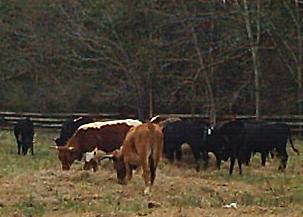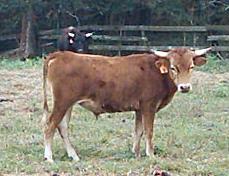How Now! How Neat!
on Tuesday, November, 13 2012 11:44:49 pm , 1016 words
Categories: Uncategorized , 65715 views

A friend on a social-networking blog site once asked if bulls are born with little lumps on their heads where the horns grow? She also noted a cartoon her youngest child watched. He apparently knew that cow meant the females of the species and had commented that they have a "male cow in the cartoon" and thus surmised "there must be male cows someplace!"
A cow, of course, is the female of several species of animals: elephants, moose, and whales, for example, as well as those large domesticated bovines which we generally call cattle. In such instances, the males are generally referred to as bulls, as in bull elephant, bull moose, bull walrus, for example, and the young are called calves (calf in the singular). Cattle is the plural word we most often use to refer to members of the genus Bos. Bos taurus are cattle breeds such as Angus, Hereford, Charolais, Shorthorns, also known as Durhams, and so on, which originated from European and west Asiatic wild species of cattle. Bos indicus cattle are the breeds associated with India and southeast Asia. The breed of Bos indicus bred in America is the Brahman. (Brahman cattle were the first breed of cattle developed in the United States, excluding the naturally selected Texas Longhorn, later given recognized breed and herd book status.) Several beef breeds are mixtures of both of these domesticated species: Santa Gertrudis, Brangus, Red Brangus, Beefmaster, and so on.
The word cattle, however, means all livestock, especially hoofed livestock: pigs, horses, donkeys, milk cattle, meat cattle, sheep, and goats. It is related to chattel, and derives from the Old French word catel, which means moveable property, as opposed to real property (land and buildings). (Even slaves were called chattel, a unit of personal property.)
Why do we have a domesticated animal that colloquially is referred to by the name we use for the female of the species? Cows, females of beef and milk cattle, and their male counterparts, bulls, are indeed livestock but obviously not horses, not pigs, not sheep, not goats---so, what are they (more precisely, what are they correctly called)? Ever oil your baseball glove with a substance called neat's-foot oil? Well, only in that sense do we continue to utilize the best, most accurate, word for these large mammals: Cows are neat! Yep, they're nifty, especially if you own them and can make a living from them, but their actual name in English is neat. They are neat cattle.
There are cow neat, and there are bull neat. Really neat, huh! Too bad so few people nowadays know it or care to use it, such that we have let the word fall by the wayside and thus instead of being able to identify the animal specifically, we childishly settle for glaringly inaccurate "close enough" terms like cow and cattle.
Another term often used to indicate these large domesticated cloven-hoofed range and barnyard ungulates is ox (oxen in the plural). Although the term can be used in referring to any of several bovine mammals of the genus Bos or related genera, such as gaur, yak, buffalo, and bison, the term is most commonly used to mean a steer of at least four or five years of age that has been trained for work. The term was at one time even applied generally to any bovine (male or female) used to do work. The condition of being work animals has long been a criterion in the use of the term. In old records (such as tax lists) which consist in part in lists of property, oxen were listed separately and distinctly from animals noted therein as "cattle" or "cows."
All neat (cows and bulls) have horns, unless they are of a naturally hornless strain, called polled (or pollard) cattle, once commonly known also as muleys or mulleys (which term derives from maol in Scottish and Irish Gaelic and moel from Welsh). Angus (both Black Angus and Red Angus) are polled, as are some Herefords, called Polled Herefords. There is a Polled Shorthorn (Durham) breed. There was a breed once very popular that has declined in popularity in the United States called Red Polls. Texas Longhorns are actually not the descendants exclusively of Spanish mission cattle that went wild, but the descendants of English Longhorn Durhams brought to Texas from the Carolinas in the early years of the Anglo-American colonization of Texas. During the War Between the States, these cattle too went wild and bred with the wild Spanish cattle. So, the long horns are primarily due to the "shorthorn" (Durham) cattle (but the long-horned variety, Longhorn Durhams) that the colonists brought with them.
Horns, of course, are not on young calves. They grow from a bud by means of a growth ring and eventually become attached to the skull. Horns are composed largely of keratin, the key structural component found in nails (fingernails, toenails, claws, and hooves) and hair. The keratin and other proteins composing the horns grow around a core of bone and become a permanent sheath around and emanating from the bone core, but horns per se are not bone (unlike antlers of animals, such as deer, which are bone).
In seeking to be specific so as not to mean goats or sheep or any other livestock, neat were often referred to as horned cattle (whether horned or polled).
Some references, such as some dictionaries, now designate the term neat "obsolete" or "rare." In other words, people have opted for imprecise terms such as cattle (livestock), cow (a female of any number of animals), and ox (an altered male bovine used to do work) to awkwardly, inaccurately refer to a single member of the species Bos taurus or Bos indicus.
A male of the genus Bos is not a cow, nor is an entire herd of these animals cows! Wouldn't it be NEAT if we could restore a perfectly good old word to specifically and correctly designate an animal so much a part of the growth and development of civilization and a valuable part of our modern world economy?

Feedback awaiting moderation
This post has 4 feedbacks awaiting moderation...
